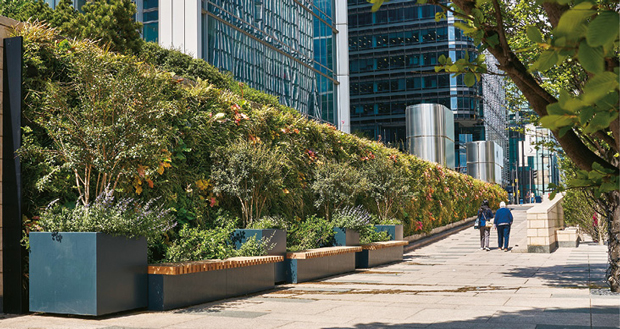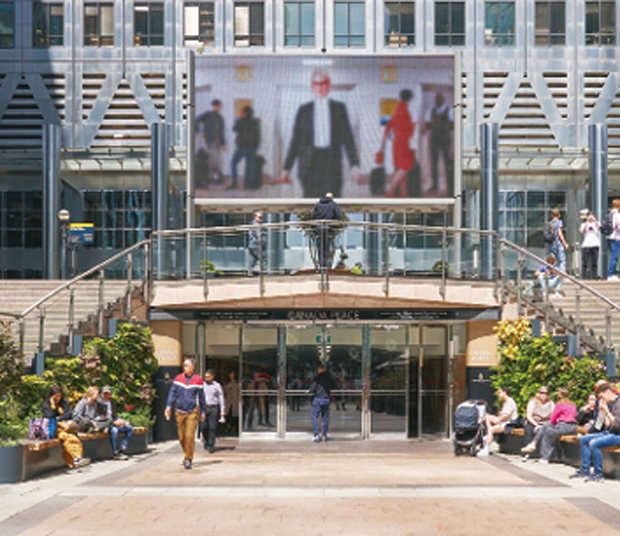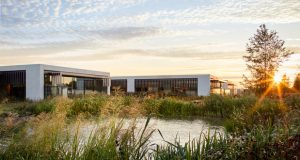Richard Sabin, Managing Director of living wall company Biotecture looks at why facilities management companies and developers such as the Canary Wharf Group are introducing living walls into their developments, to encourage people to return in larger numbers
A 2022 survey by the Office for National Statistics (ONS), showed that over 80 per cent of workers who worked from home during the pandemic were planning to continue working remotely or on a hybrid basis.
A 2021 report by the Centre for Economics and Business Research (CEBR), calculated that the pandemic had already resulted in an £11.9 billion reduction in spending, which would have otherwise been spent in shops, eateries and pubs near major employment hubs in five of the UK’s biggest cities.
The report stated that if hybrid working were to continue over the longer term, those cities would experience a reduction in spending of £322 million a month, compared to pre-pandemic spending.
BOOST WELLBEING
To entice people back into offices and retail settings, facilities managers need to consider how they can create more inspirational spaces that people want to spend time in.
There is a huge amount of evidence showing the value of adding living walls to indoor or outdoor spaces, from offices and stations to shopping centres and schools.
Incorporating a living wall can boost wellbeing in many ways. They make people’s surroundings more aesthetically pleasing and relaxing, as well as adding large quantities of toxin-cleaning plants to their immediate environment. Breathing cleaner air leads to better overall health, and being surrounded by plants has also been shown to have a positive effect on our mental health. For employers, the result is reduced sickness, better retention and happier staff.
Additionally, because they produce their own fresh air, internal living walls can actually reduce a building’s energy consumption and ventilation costs by reducing the number of required air changes per hour.
WORKPLACE SATISFACTION
Research has shown that if people can see plants while they’re working, their concentration levels, productivity and creativity all improve.
In one study by Echo Research, employees stated that they’d feel 62 per cent more motivated if their employers improved their surroundings, and estimated that they’d be 30 per cent more productive as a result. Factors such as good ventilation, natural light and greenery were all cited as important aspects of workplace satisfaction.
In a 2014 study by the British Council for Offices, 45 per cent of workers said that they would move to a new job if the working environment was better, even if their role, salary and benefits stayed the same.
RECONNECTING PEOPLE WITH NATURE
Living walls on the exterior of buildings also deliver a huge range of benefits, such as removing harmful pollutants from the air, enhancing wellbeing and productivity, reducing urban temperatures and improving biodiversity.
Traditional, ground-level planting is not always possible in urban centres where space is at a premium. Living walls make the most of vertical spaces, and offer a cost-effective way to reconnect people with nature.
ENRICHING THE PUBLIC REALM
As part of their commitment to providing inspiring spaces that enrich the public realm, contribute to their ambitious sustainability goals and attract more footfall, Canary Wharf Group commissioned us to install living walls in several key locations across their estate.
The living walls were designed to create a natural, vibrant feel while maximising the ecological benefits. Plants were selected and combined to ensure they provided year-round visual interest through colour, shape, movement, and texture.
The living walls for Canary Wharf Group were created using ‘PlantBox’, our stackable living wall system, which can be extended, reconfigured or even relocated as requirements change.
Manufactured in the UK from 100 per cent recycled materials, the troughs were planted up in our nursery before being installed on site in several phases. This ensured the living walls looked beautiful from day one.
As the system is loadbearing and only requires restraint fixings, the living walls at Canary Wharf didn’t need structural approval, which enabled us to offer a fast turnaround on the project.
Following completion of the first phase of the project, we were appointed to design and deliver several biodiversity boxes and additional living walls to commemorate the opening of the Elizabeth line. Our expert horticultural team also carry out regular inspections and maintenance to keep the living walls looking their best.
Clearly, in order to encourage and attract people back into workplaces, retail developments and high streets, facilities managers, architects and developers alike need to provide something extra that people simply can’t experience at home.
Living walls are an effective, sustainable way to create inspirational spaces that reconnect people with nature, making them feel happier, healthier and more satisfied with their surroundings. It definitely beats working from the dining table!






